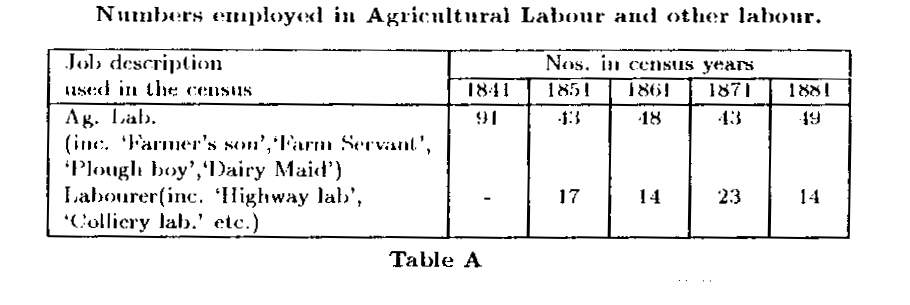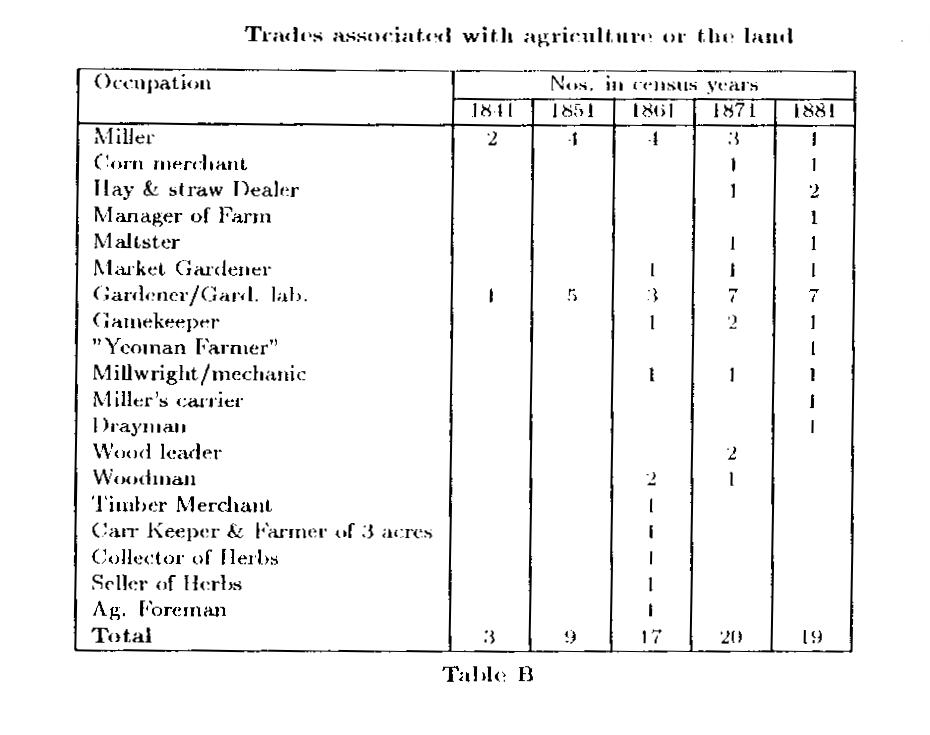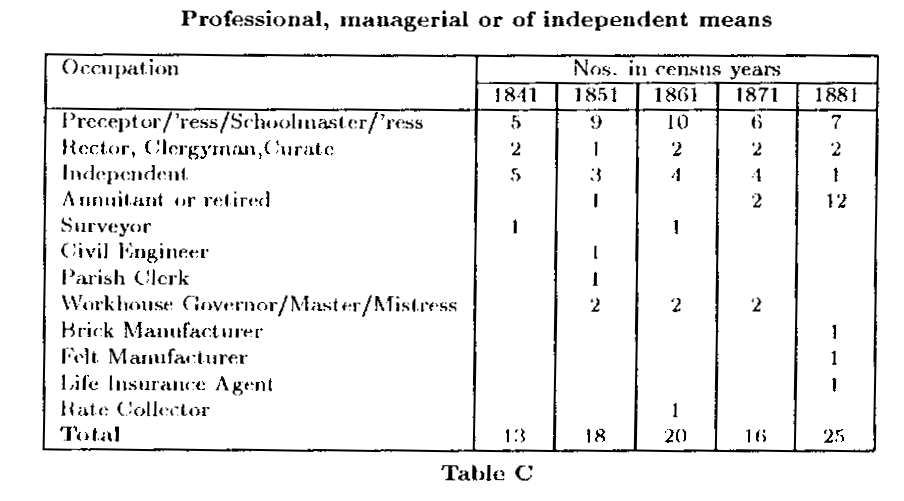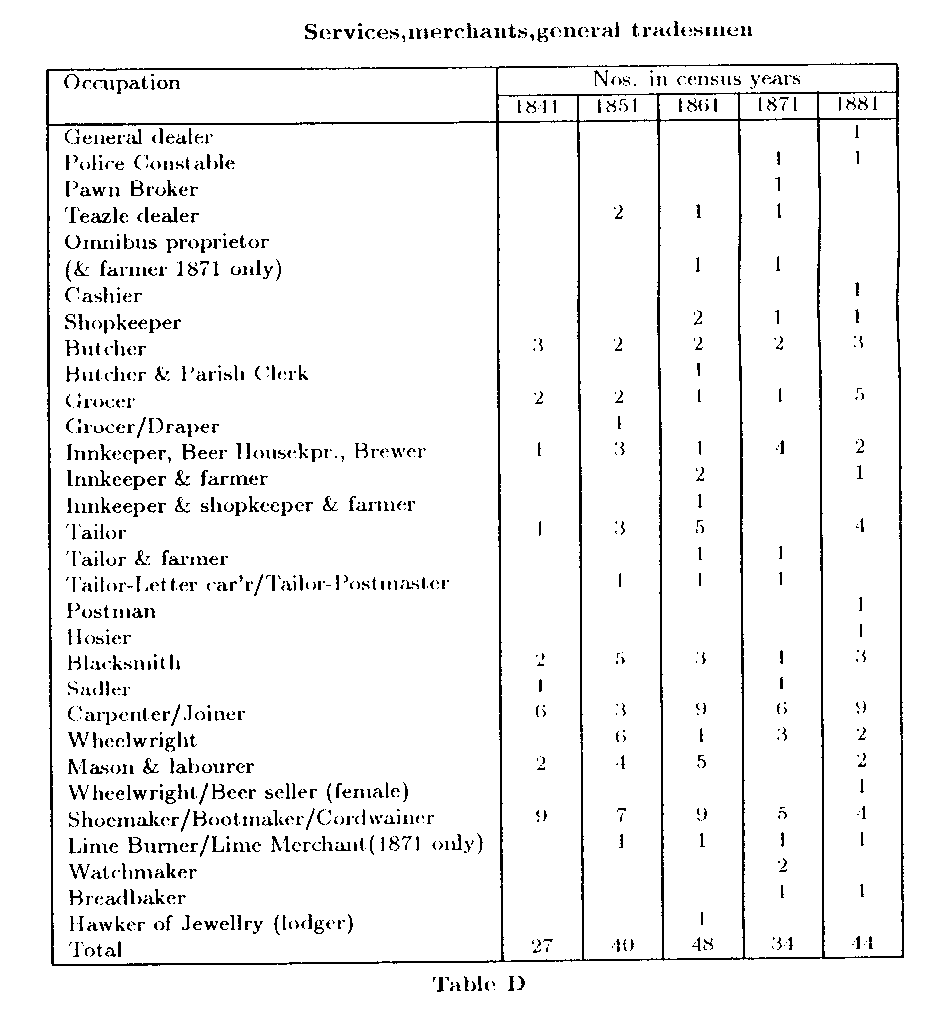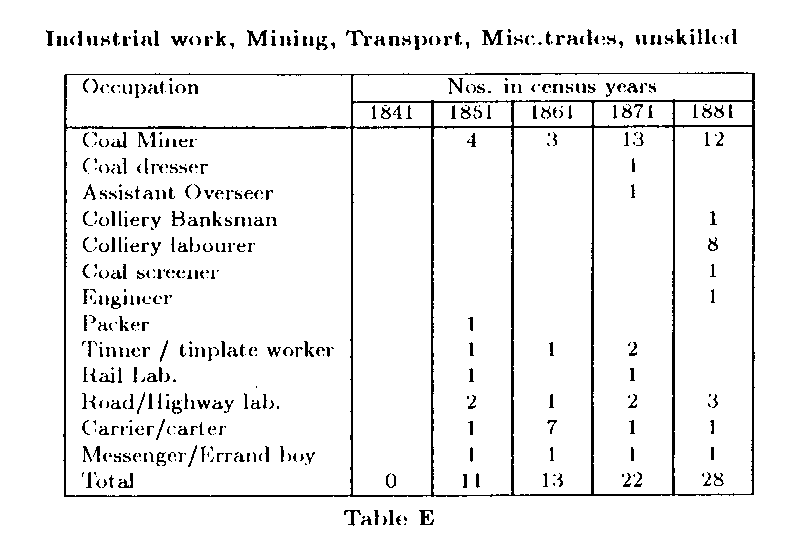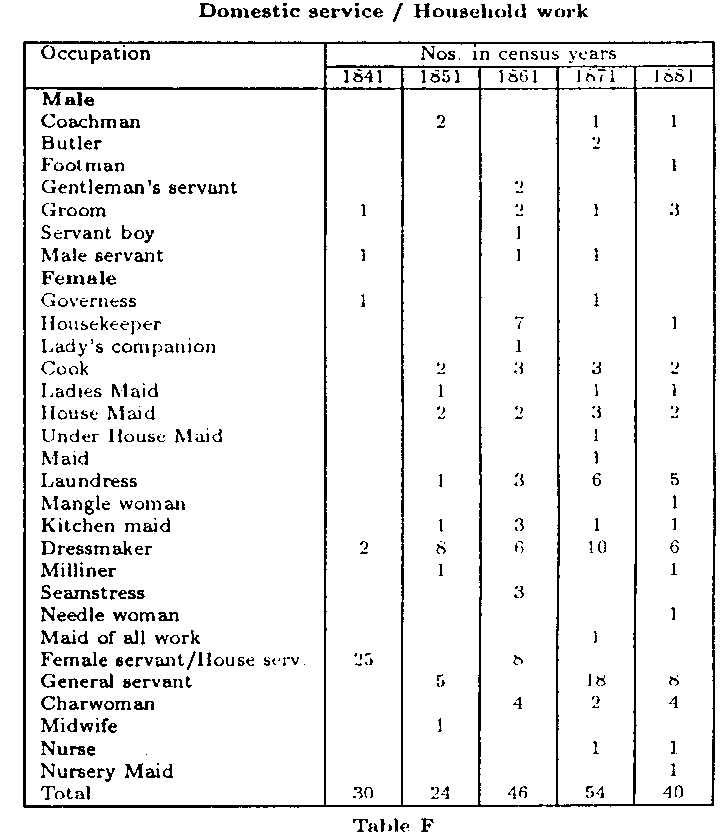Work and Status
EMPLOYMENT IN VICTORIAN BARWICK
Back to the Main Historical Society page
Back to the Barwicker Contents page
Work and Status
EMPLOYMENT IN VICTORIAN BARWICK
Barwicker No 28
December 1992
The Society has now acquired copies of the census returns from
the village for the years 1841 to 1881. The 1891 census has only
just been released for inspection and has not yet been studied in
detail. This article is based upon a detailed examination of the
census returns completed every ten years from 1841 to 1881.
Besides telling us basic details of the number of inhabitants and
who lived in the Village, the census returns from 1841 have given
details of the jobs of inhabitants or the status of those fortunate
enough to have work and those unfortunate not to have a job.
By analysing the occupations and standing of inhabitants, it is
possible to consider how prosperous the Village was and the source
of its economic standing. Tbe analysis shows clearly tbe
dominance of agriculture in the life of the Village. The number of
farmers resident within the village as opposed to those living in
the fields away from the village declined marginally during the
forty years from 18 to about 15.
The farms were small, an average of 70 acres, and were clearly
not large enough for the farmers to be prosperous as a number
combined farming with other jobs. In one case, in 1881, Yill1am
Thompson records that besides being a farmer of 40 acres employing
one labourer, he is also a butcher and the Parish Clerk. In a
number of cases farmers relied upon members of the family as
regular labourers and a few employed more than one or two
permanent labouring staff.
A count of the number of agricultural labourers has given a
suprising result. In Table A below it can be seen that there is a
halving of the number of agricultural labourers between 1841 and
1851. During the decade, employment in agriculture entered a
depression from which it never recovered. The number of farms did
not decrease so farmers coped without employing staff at the same
level. Ye do not as yet know the exact cause of this event, except
that this decade saw the repeal of the Corn Laws and the
introduction of chemical fertilisers and increased mechanisation.
As yet we do not know the extent to which these improvements were
introduced in Barwick-in-Elmet. Agricultural production does not
appear to have suffered as we see for instance a doubling of the
number of millers in the village from two to four during the
decade. Clearly there is much more investigation to be done on
this topic.
So what happened to those fifty or so agricultural labourers of
18417 From 1851, we have a new occupation listed, 'the labourer',
including specialist labourers such as 'highway labourers' and
'colliery labourers'. Of all those listed as non-agricultural
labourers in 1851, which we can trace as having an occupation in
1841, all were agricultural labourers in 1841. There appears to
have been some form of 'job creation' initiative in the 1840s.
There was some diversification out of agriculture into industry. A
comparison of the employment in the village shows that the
villagers started to be employed in coal mining during the decade
and the range of trades and services in the village increased as
well.
The continued importance of agriculture throughout the period
is demonstrated by a list below (Table B) of those employed in
occupations in support of agriculture. Note the increasing range
of specialist occupations during the period. For instance, the
number of millers declined from four in 1861 to one in 1881 but
there was a millwright/mechanic and a miller's carrier in that
year. The presence of both a collector and a seller of herbs (both
women) in 1861 may reflect the state of the economy at the time
rather than a genuine growth in employment opportunities.
Table B shows that employment in this sector grew considerably
during the mid-Victorian period,. This provides testimony to the
idea that the village continued to be primarily dependent upon
agriculture for its livelihood.
On the reasonable assumption that the village's farmers
produced more food than could be consumed in the village, farming
was a source of income for the village. The census returns show
us that there were no other significant indigenous occupations in
the village which created exportable wealth. Another creator of
income from outside the village was education. Throughout the
middle years of the last century there were one or more private
schools for young ladies in the village. Whilst having only a
dozen or so boarding pupils the schools did provide both
employment and demand for local services.
The Village was also home for a number of retired business
people from Leeds, and even from London, all of whose wealth was
from outside the village. They too would have created demand for
local services. In the case of those in professional callings such
as clergymen and teachers in the local school their income was
from local sources. A list of inhabitants who were either members
of a profession or who were of independent means is given below:
The table shows a doubling of the number of inhabitants of
such status throughout the period from 1841-1881. Bote
particularly the rise in the number of retired people in the last
decade. This to some extent reflects the development of modern
services based upon the increasing wealth at the time as witnessed
by the presence of an insurance collector in the village.
There was a more erratic expansion of opportunities for
employment in services in the village (see Table D). The list
shows a similar pattern of increased specialisation in occupations
over the forty years. The Police Constable, introduced in the
period 1861-71, and the Postmaster and Postman, would all have
been public servants and consequently paid from funds from outside
the village. Most of the other occupations listed in Table D were
reliant on internal wealth of the Village for their livelihood.
Note the significant increase in the numbers employed in the
trades between 1841 and 1851. The list also includes a number of
farmers who became part-time farmers and diversified into other
occupations such as brewing, shopkeeping and tailoring. The list
also gives some idea of what people did for themselves. There was
no baker until after 1861. Note that there are few employed in the
building industry in the Village. There were only masons and
joiners in the Village and their numbers fluctuated. Conversely the
list shows the effect of industrialisation on the trades. The
numbers of boot and shoemakers in the village halved; presumably
people bought factory-made boots and shoes rather than hand-made
ones.
Table E shows the changes in the number of villagers moving
from farming into industry in the 1840s. No villager in 1841 was
employed in industry. By 1851 the number was 11 and by 1871 the
number had doubled due to the opening of mines to the south of the
village. Increasingly after 1851 more worked in transport,
particularly road transport and road maintenance. There was little
opportunity for the railways to offer employment to the villagers,
particularly after the failure to attract railways to the village
(see 'The Barwicker' No.27). All the income from industrial work
came from outside the Village. Therefore when combining the income
from investments, savings and pensions with that earned from
industry there was a substantial portion of the village's economy
which relied upon external conditions by the end of the period.
The remaining category of occupation in the village was
domestic service which employed over double the numbers employed
in industry and was a valuable source of work for women. The
numbers employed are listed in Table F. The numbers employed in
domestic work fluctuated markedly and, with the exception of 1871,
there was little change in numbers from 1841 to 1881. Jobs became
more specific as the period progresses. The Rectors employed
between five and eight resident staff as well as unknown numbers
of non-resident staff.
In conclusion therefore we can see that during the middle of
the 19th. century Barwick-in-Elmet was to all appearances a Village
dependent on farming with its 15 to 18 farms in the village itself.
There was no industry but there were plenty of services for the
inhabitants. Village life must have been sufficiently pleasant,
comfortable and convenient to attract the retired middle class and
respectable schools for young ladies. ~e have seen that there was
sufficient wealth in the village for a substantial proportion of
the Village to be employed in domestic service. At the same time
there was industry sufficiently close to give further employment
opportunities to the village. By the end of the period 1841-1881
the village had been transformed from a virtually self-sufficient
community to one which was developing substantial economic ties
with the outside world. 'We know from the village of today just
how far that process was to go.
Harold Smith
Back to the top
Back to the Main Historical Society page
Back to the Barwicker Contents page
